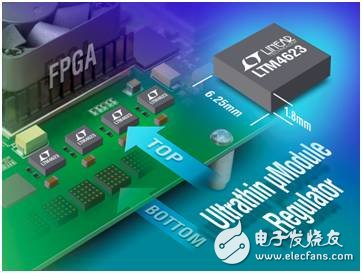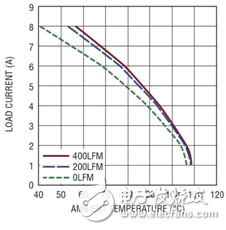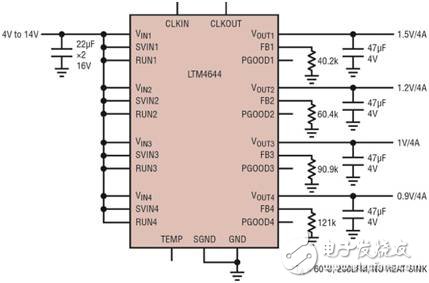In this context, the design team has to adapt to new ways of working, such as cross-functional departments, work across multiple locations, while experts in some design fields such as power and RF are becoming scarcer and time to market. shorten.
Fortunately, to help the design team, each new generation of semiconductor products brings technological improvements, and as this technology improves, innovation flows from one industry to another. One product line that clearly demonstrates this technological improvement is Linear Technology's μModule (micromodule) regulators, which have achieved the ultimate in power solutions through advances in integrated chip and packaging technologies. Great improvement.
Efficiency Size, Weight, and Power (SWaP) This term is commonly used in the defense industry to convey the idea of ​​technological system advancement. If we delve further into the essential meaning of this term, then reducing SWaP means efficiency.Efficiency is key because there are ready-made contradictions. For a small and lightweight system, the system needs to operate at low temperatures for reliability. However, with the increasing complexity of digital processing tasks, power requirements are also increasing. This of course means that both the processing core and the power components will generate more heat unless the solution improves efficiency.
Linear Technology's μModule regulators provide a solution for improving the efficiency of the power subsystem. To demonstrate this, let us consider efficiency issues in a broader sense, rather than purely considering the most obvious efficiency concept of electrical conversion efficiency.
Physical size and PCB footprintIn 2008, Linear Technology introduced the LTM8020 μModule Regulator, a complete 200mA step-down DC/DC power supply in a tiny 6.25mm x 6.25mm x 2.32mm plastic LGA package. This product meets EN55022 Class B radiated EMI requirements and is rapidly adopted as a standard building block in many types of systems.
In 2014, Linear Technology introduced the LTM4623 ultra-thin μModule regulator, which now features 3A output capability and the same radiated EMI performance. Due to component technology and package improvements, the device occupies the same 6.25mm x 6.25mm board area, but is only 1.82mm high, providing the option of mounting on the back side of the PCB in some systems.

Figure 1: LTM4623 Ultrathin 3A Step-Down DC/DC μModule Regulator
For applications that require more power, the LTM4625 provides 5A DC output current while occupying the same board area at a height of 5.01mm, which is caused by the large internal inductor and BGA package.
Another example of increased integration in 2014 is the LTM4634, a three-output 5A/5A/4A step-down DC/DC μModule regulator. The device is available in a single 15mm x 15mm x 5.01mm BGA package and provides three independent high efficiency regulator channels. Compared to the first device in the series in 2005, the LTM4600 single-output 10A step-down DC/DC μModule regulator has the same footprint.
Electrical performanceThe basic regulator IC's conversion efficiency is improved, along with advances in packaging technology. This advancement improves thermal performance. Therefore, the newer μModule regulator can now be higher for a given output current. Operating at ambient temperature provides a greater design margin.
For example, we can compare the temperature derating curves of two products with the same package size, one is the 8A step-down DC/DC μModule converter LTM4608A and the recently introduced 10A step-down DC/DC μModule regulator LTM4649.
Figures 2 and 3 are based on a configuration without a heat sink, 5V input, and 3.3V output. The derating curve is plotted with the output current, starting at the maximum rating and an ambient temperature of 40 °C. The junction temperature is maintained at a maximum of 120 °C while the output current is reduced as the ambient temperature increases. When the ambient temperature rises, lowering the output current will reduce the internal module losses. The monitored 120°C junction temperature minus the ambient operating temperature results in an allowable rise in module temperature.

Figure 2: LTM4608A Thermal Derating, 5 VIN to 3.3 VOUT

Figure 3: LTM4649 Thermal Derating, 5 VIN to 3.3 VOUT
These curves show that the newer LTM4649 can operate without thermal derating at an ambient temperature of 90 °C, while at the same temperature, the LTM4608A must be derated by approximately 50%. This is especially true for military systems that do not have forced air cooling, where ambient temperatures of up to 80 ° C to 90 ° C are common.
Design time and design expertiseAs more and more system complexity and shorter design cycles consume design resources, the focus is on the development of key intellectual property systems. This often means that power is kept aside until the end of the development cycle. Due to the small amount of time and perhaps limited professional power supply design resources, there is pressure to propose an efficient solution with the smallest footprint.
This is where the μModule regulator provides the ideal answer; the concept is versatile and externally simple, providing the efficiency of a switching regulator and the design simplicity of a linear regulator. Careful design, PCB layout, and component selection are important when designing switching regulators. Many experienced designers have heard the unique smell of board burnt in their early careers. Off-the-shelf μModule regulators save time and reduce project risk when time is short or power supply design experience is limited.
The development of newer multi-output products is even more attractive. Figure 4 shows the simplicity of a 4-channel solution based on the LTM4644, which is available in a 9mm x 15mm x 5.01mm BGA package and can be configured for channel paralleling when needed. The external components have a single resistor for setting each output voltage, as well as large-capacity input and output capacitors.
Another advantage of flexible output configuration is the opportunity to reduce the number of device types included in the company's qualified preferred parts list, saving component engineering resources and increasing purchases.


Figure 4: LTM4644 Quad 4A μModule Regulator with Configurable Output Array
Safety and reliability featuresThe interconnect reliability of the bottom termination assembly (BTC) has long been an industry concern, and some large defense contractors have conducted many internal studies to determine the environmental suitability of different BTC package types. Linear Technology has also conducted research in which daisy-chained products undergo thousands of hours of temperature cycling to determine the reliability of the soldered interconnect.
Since the introduction of the first μModule regulator LTM4600 in an LGA package (with gold-plated square pads), much work has been done to improve the physical layout and internal design features of the pads. Later, the BGA package was introduced and the customer was offered the choice of a spherical structure of SAC305 or SnPb. This choice is critical for many military systems, which are in a very demanding environment, and the use of SnPb components is still preferred, especially for BTC.
For applications where safety is critical, the functionality of newer products is also helpful in design work, for example, returning to the LTM4644 four-channel 4A μModule regulator discussed earlier, which features the following features:
• Internal temperature sensing is provided by a diode-connected PNP transistor with a temperature coefficient of approximately -2mV/°C. This transistor can be connected to an external ADC to provide data to the control system.
• Overheat protection monitors the junction temperature in the module. If the junction temperature reaches approximately 160 ° C, the output is turned off until the temperature drops by approximately 15 ° C.
• Overcurrent and overvoltage fault conditions are protected by internal circuitry that performs a foldback current limit and monitors the output feedback voltage within a window of ±10% around the settling point.
Other safety features offered in this product line include adjustable input and output average current limits, input and output current monitors, and a complete digital interface and control with built-in EEPROM for fault logging.
in conclusion:
Advances in semiconductor and packaging technology have led to continuous improvements in products. This article is devoted to the μModule regulator solution and how this solution can help designers achieve new performance goals in the following areas:
Improved? SWaP solutions and reliability
? Â Â Shorten the listing process and reduce risk
? The best way to play the role of design team and support resources
Pond Filtration Pumps,Canister Filter,Frequency Outside Filter,Garden Pond Pressure Filter
Sensen Group Co., Ltd.  , https://www.sunsunglobal.com